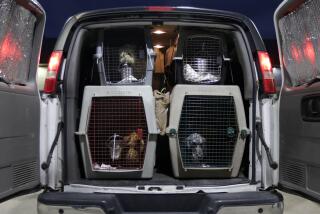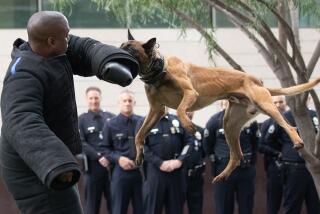Hidden Treasures in Sylmar : * Facilities housing vintage cars, musical instruments and guide dogs are tucked into the suburban landscape.
SYLMAR — To most people, Sylmar probably evokes images of one of two things--the reservoir or the 1971 earthquake. But a couple of unexpected treasures for the incurably curious are hidden in this suburban landscape at the north end of the San Fernando Valley.
First stop is the Merle Norman Cosmetics factory, 15180 Bledsoe St., just off San Fernando Road. The tour has nothing to do with the factory, where only the containers for the cosmetics are made. (The cosmetics are manufactured in Westchester.)
The huge building next to the factory is San Sylmar, home of the Merle Norman Classic Beauty Collection of “functional fine art”--in this case, cars and musical instruments, along with an eclectic display of other items. The museum is open free to the public. Tours are at 10 a.m. and 1:30 p.m. Tuesdays through Saturdays. Weekday tours are readily available, but Saturdays are booked weeks in advance. Call (818) 367-2251 for reservations, which are required. This tour has a dress code--no jeans or shorts, so guests will fit in with the lavish ambience. Non-flash photography is allowed, but not tape or video recorders.
9:55 a.m.: After a few minutes, our group of about 35 visitors is allowed into a lower level to browse among antique cars, most of them Rolls-Royce models from 1913 to 1979.
10:15 a.m.: After meeting our host, museum curator Byron Matson (a droll, Dan Rather look-alike), we are escorted upstairs through 10-foot-tall brass doors, which, though they could pass for 15th-Century Italian, were cast in Burbank in 1970. Ground was broken on this building in 1969. The structure survived the ’71 quake (though some of the collection was damaged) and opened for tours in 1974.
A turn-of-the-century music box plays as we enter the “salon,” where we gape at the vast marble floor, columns and crystal chandeliers. This huge, faux-European ballroom was built to display the collection of pristine antique cars--all of which are ready to drive, but are placed on the polished marble floors by some sort of air pallet so their tires won’t leave marks.
Amazingly, we are invited to step right up and check out the cars--but are asked not to touch. The collection includes an 1886 Benz three-wheeler, boasting one cylinder and one horsepower. A coiled silver cobra adorns the radiator cap of a 1923 Avions Voisin roadster once owned by silent-film star Rudolph Valentino. The vanity plate on a 1923 McFarlan runabout reads “Fatty” for its one-time owner, silent-screen comedian Fatty Arbuckle. There are dozens of cars.
10:45 a.m.: A sweeping staircase leads to the mezzanine and a room-length glass display case of about a thousand radiator caps and hood ornaments. This is the epitome of Hollywood--an entire case of Lalique crystal ones, some of which were wired to light up at night.
11 a.m.: We climb another spiral staircase (elevators are available) and enter another grand room, this one containing the other half of the San Sylmar collection--”mechanical musical instruments,” a.k.a. player pianos. As we enter, a 1929 Mason & Hamlin parlor grand regales us with a cheerful rendition of Liszt’s “Hungarian Rhapsody No. 2.” Thankfully, this room contains a number of comfy chairs, so we can sit and be entertained by brief recitals from a number of the fascinating, turn-of-the-century instruments.
There are several enormous, European-built “orchestrions,” which mechanically approximate the sound of an entire orchestra and were used at restaurants, hotels and dance halls. A theater organ replays a computer-recorded recital of “Stairway to the Stars.” The group applauds, even though there’s no musician present.
Noon: Our tour concludes with a brief but tasteful sales pitch for Merle Norman cosmetics. We exit to the organ’s accompaniment, “Walkin’ My Baby Back Home,” a perfect theme song for our next stop.
Guide Dogs of America, 13445 Glenoaks Blvd., is just a couple of minutes away from Merle Norman, but you have enough time to drive to Valencia for lunch before the afternoon tour at 2 p.m. Tours are available at 10 a.m. and 2 p.m. daily, but groups are asked to book 30 days in advance. One or two individuals can usually join a group already booked, but call first for reservations, (818) 362-5834. When you pull up, the sign out front might still say International Guiding Eyes Inc., because the school is in the process of changing its name to the more descriptive Guide Dogs of America.
2 p.m.: In a screening room, our human guide, Deborah Sands, introduces two films, one on this facility and another on guide dogs. (Bring tissues.) The Sylmar school moved here from North Hollywood in 1981. It’s one of 11 guide dog schools in the country and was founded in 1948 by Joseph W. Jones, a blind machinist who had been denied a guide dog by the one school that existed at that time on the grounds he was too old--at 59.
He got his union to help fund this school, which now boasts graduates from age 16 to 89. It costs $20,000 to obtain, raise and train a guide dog. The blind recipient is not charged, but there is a six-month waiting list. Recipient and dog live here together and go through a 28-day training session. Here’s where the tissues really come in: Puppies are raised by volunteers until the dogs are about a year old. Then the school reassesses each dog to see if its health, agility and temperament merit full training. If the dog is accepted into the program, the puppy raiser doesn’t see it again until graduation, when they present their former puppy to its new blind owner. If you want to be a puppy raiser, it costs $3,000 to sponsor a dog and you have to have the proper setup to raise one.
2:20 p.m.: If no class is in session, you can walk through the dormitories. Students and their dogs stay together in small, comfortable rooms. Sands says many students are in the early stages of progressive blindness and still have some sight.
2:30 p.m.: Behind the main building is a big, landscaped yard and serene lily pond. Graduation is held here. Airplane steps stand in the distance, part of the training regimen. A parcel of land next door is being held in trust for the school, which relies entirely on private donations, until it can be turned into a state-of-the-art breeding facility, to be housed in a small stable that was moved here from Encino where it had been built by Clark Gable for Carole Lombard.
2:40 p.m.: As we approach the kennels, the jumping and barking starts in the pens where the dogs in training live. Golden retrievers and German shepherds are used as guide dogs, but Labrador retrievers are the most popular because of their even temperament. Most of the training occurs in shopping malls and on city streets.
2:55 p.m.: On the way out, visitors can buy such souvenirs as caps, jackets, T-shirts and pins.
More to Read
Sign up for The Wild
We’ll help you find the best places to hike, bike and run, as well as the perfect silent spots for meditation and yoga.
You may occasionally receive promotional content from the Los Angeles Times.






